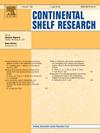Long-term variations in sea ice extent can influence trends in maximum sea level in the northeastern Baltic Sea
IF 2.2
3区 地球科学
Q2 OCEANOGRAPHY
引用次数: 0
Abstract
Compared to the relative mean sea level changes at Estonian tide gauges, the maximum sea levels have increased faster, by 10–40 cm over the past hundred years. It has been argued that the west-facing coast is sensitive to long-term changes in the westerly wind component and storminess. In addition to those, we test the hypothesis that the decrease in Baltic Sea ice cover can also be a reason for higher surges. To study trends, we use long-term sea level and meteorological data from Estonian coastal stations and ice records in the Gulf of Riga. The ERA5 forced WRF-FVCOM modelling suite is used to quantify the effect of the lack of ice cover on sea level patterns in the Gulf of Riga and on the maxima at Pärnu during three storms. According to the linear trend, air temperatures on the Estonian coast have increased by about 2.5 °C between 1950 and 2023, and the number of ice days has decreased by 62 % at Kihnu and by 42 % at Pärnu. The sea level trend-changing mechanism can apply in two ways. Firstly, some mid-winter extremely high storm surges have occurred in ice free conditions, especially in more recent decades. And secondly, when some strong winter storms did not cause remarkably high sea level events in the ice-covered Gulf of Riga, but the FVCOM indicated the potential for storm surges of at least 60 cm higher than took place. Such events could have had a notable impact in the first half of the 20th century, when seasonal ice cover on the Baltic Sea was more extensive than it is nowadays. The combination of a decreasing ice trend and an increasing probability of undamped storm surges can contribute to a steepening of sea level maxima and higher quantile trends in centennial time series.
海冰范围的长期变化可以影响波罗的海东北部最高海平面的趋势
与爱沙尼亚潮汐计的相对平均海平面变化相比,在过去的一百年里,最高海平面上升了10-40厘米。有人认为,面向西方的海岸对西风成分和暴风雨的长期变化很敏感。除此之外,我们还测试了波罗的海冰盖的减少也可能是浪涌加剧的一个原因的假设。为了研究趋势,我们使用了爱沙尼亚沿海站的长期海平面和气象数据以及里加湾的冰记录。ERA5强迫WRF-FVCOM模型套件用于量化在三次风暴期间,里加湾冰盖缺乏对海平面模式和Pärnu最大值的影响。根据线性趋势,爱沙尼亚海岸的气温在1950年至2023年间增加了约2.5°C, Kihnu的结冰天数减少了62%,Pärnu减少了42%。海平面趋势变化机制可以在两方面发挥作用。首先,在冬季中期,特别是最近几十年,在无冰条件下出现了一些极高的风暴潮。其次,当一些强烈的冬季风暴没有在被冰雪覆盖的里加湾引起明显的高海平面事件时,FVCOM显示风暴潮的可能性至少比实际发生的高60厘米。这样的事件在20世纪上半叶可能会产生显著的影响,当时波罗的海的季节性冰盖比现在更广泛。冰的减少趋势和无阻尼风暴潮可能性的增加相结合,可导致海平面最大值变陡和百年时间序列中更高的分位数趋势。
本文章由计算机程序翻译,如有差异,请以英文原文为准。
求助全文
约1分钟内获得全文
求助全文
来源期刊

Continental Shelf Research
地学-海洋学
CiteScore
4.30
自引率
4.30%
发文量
136
审稿时长
6.1 months
期刊介绍:
Continental Shelf Research publishes articles dealing with the biological, chemical, geological and physical oceanography of the shallow marine environment, from coastal and estuarine waters out to the shelf break. The continental shelf is a critical environment within the land-ocean continuum, and many processes, functions and problems in the continental shelf are driven by terrestrial inputs transported through the rivers and estuaries to the coastal and continental shelf areas. Manuscripts that deal with these topics must make a clear link to the continental shelf. Examples of research areas include:
Physical sedimentology and geomorphology
Geochemistry of the coastal ocean (inorganic and organic)
Marine environment and anthropogenic effects
Interaction of physical dynamics with natural and manmade shoreline features
Benthic, phytoplankton and zooplankton ecology
Coastal water and sediment quality, and ecosystem health
Benthic-pelagic coupling (physical and biogeochemical)
Interactions between physical dynamics (waves, currents, mixing, etc.) and biogeochemical cycles
Estuarine, coastal and shelf sea modelling and process studies.
 求助内容:
求助内容: 应助结果提醒方式:
应助结果提醒方式:


